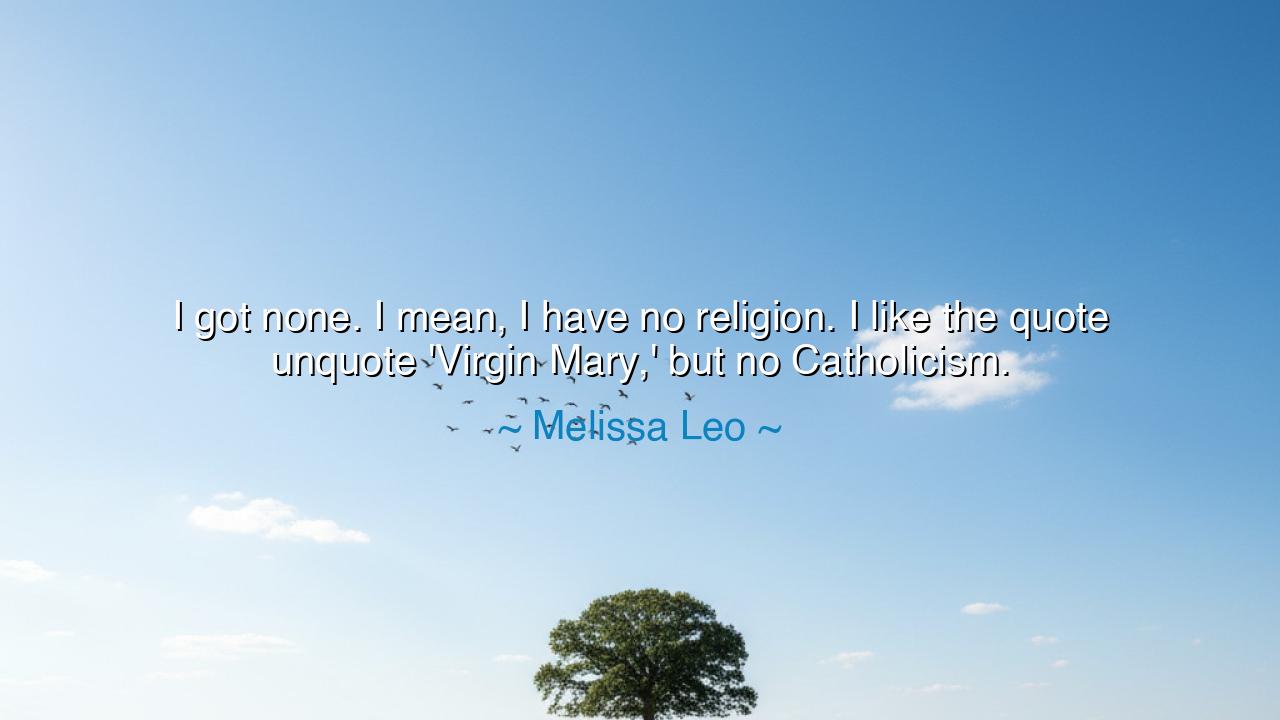
I got none. I mean, I have no religion. I like the quote unquote
I got none. I mean, I have no religion. I like the quote unquote 'Virgin Mary,' but no Catholicism.






Hear, O listener, the candid voice of Melissa Leo, who declared with fearless honesty: “I got none. I mean, I have no religion. I like the quote unquote ‘Virgin Mary,’ but no Catholicism.” These words, spoken without ornament, carry a deeper truth of the human spirit. They reveal the struggle between the yearning for symbols, for figures of comfort and inspiration, and the rejection of institutions that sometimes burden those symbols with dogma and demand. It is the cry of one who finds beauty in fragments but cannot dwell within the structure that contains them.
Consider first the weight of saying, “I have no religion.” This is not merely a statement of unbelief, but a declaration of independence. For millennia, people have been born into faiths as they were born into families, without choice. To stand apart is to carve one’s own road, to live without the shelter of tradition, but also without its chains. It is both a freedom and a loneliness, a wide-open field where the soul must build its own meaning.
Yet Leo tempers this with reverence for the Virgin Mary, a figure who transcends creed and dogma. For Mary, whether seen through Catholicism or through the lens of art, story, and archetype, represents purity, motherhood, compassion, and resilience. To admire her apart from religion is to acknowledge the universal power of symbols. Across centuries, the image of the grieving mother, the gentle protector, has comforted the broken and inspired the weary. Thus, Leo’s words reveal a paradox: rejection of religion does not mean rejection of the sacred.
History, too, speaks with the same voice. Recall the Renaissance painters, who filled churches with images of saints and angels. Many who gazed upon those works were not devout theologians, but common people stirred by the beauty of the forms. The art lifted their spirits even if the doctrines behind them were beyond grasp. In the same way, one may admire the figure of Mary or the story of Christ without binding oneself to the authority of the church. The sacred can live outside the walls built to contain it.
The meaning, then, is clear: faith and religion are not always the same. Religion is structure, institution, rule, and ritual. Faith—or the recognition of what is sacred—can exist even in the heart of the unbeliever. One may reject dogma and still kneel before beauty. One may deny the authority of priests and still honor the tenderness of a symbol like the Virgin Mary. In this distinction lies the freedom to seek one’s own truth, to embrace the fragments of the divine that speak most powerfully to the soul.
The lesson for us is this: do not scorn those who walk without religion, for they may yet carry reverence in their hearts. And do not assume that to honor the sacred is to submit wholly to tradition. Each soul must navigate its own path between belief and unbelief, between symbol and structure. The sacred is not diminished when it is seen outside of its institution; often it shines even brighter.
Practical counsel follows. Seek symbols that stir your spirit, even if you do not claim the religion they come from. Allow yourself to be moved by art, by story, by figures of compassion, without fear of contradiction. But also respect those who choose the shelter of religion, for their path is as valid as yours. The greater wisdom is to recognize that what nourishes the human heart may come in many forms, sometimes within tradition, sometimes beyond it.
Therefore, O seeker, remember Melissa Leo’s words: to have no religion is not to be empty, for one may still find beauty in what endures—the sacred figures, the timeless stories, the symbols that transcend creed. Walk boldly upon your path, whether with temple or without, but never cease to seek that which lifts the heart, comforts the sorrowful, and awakens reverence within you. For the sacred belongs not only to the church, but to all humanity.






AAdministratorAdministrator
Welcome, honored guests. Please leave a comment, we will respond soon